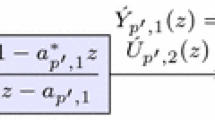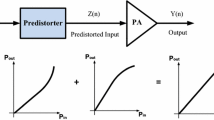Abstract
In this article, we present a novel method for modeling radio frequency (RF) power amplifiers (PAs). The proposed method for baseband data generation introduced in this paper, enables us to specify operational power range and bandwidth criteria of the PA, yielding a generic power amplifier model, which includes both memory effects as well as non-linearity of the PA. Further, we show that, the modeling approach is useful for bit error rate (BER) computations with PA distortions for any digitally modulated signal. Estimated BER using the proposed PA model for the test case of QPSK and 16-QAM, shows a significant difference in BER at high input back-offs due to memory effects, compared to the conventional non-linear PA models.








Similar content being viewed by others
References
Joung, J., Ho, C. K., & Sun, S. (2013). Spectral efficiency and energy efficiency of OFDM systems: Impact of power amplifiers and countermeasures. IEEE Journal on Selected Areas in Communications, 32(2), 208–220.
Fager, C., Eriksson, T., Barradas, F., Hausmair, K., Cunha, T., & Pedro, J. C. (2019). Linearity and efficiency in 5G transmitters: New techniques for analyzing efficiency, linearity, and linearization in a 5G active antenna transmitter context. IEEE Microwave Magazine, 20(5), 35–49.
Ghannouchi, F. M., & Hammi, O. (2009). Behavioral modeling and predistortion. IEEE Microwave Magazine, 10(7), 52–64.
Guan, L., Zhu, A., & Communications, G. (2014). IEEE Microwave Magazine, 15(7), 84–99.
Schetzen, M. (1989). The Volterra & Wiener Theories of Nonlinear Systems. New York: Wiley.
Isaksson, M., Wisell, D., & Rönnow, D. (2005). Wide-band dynamic modeling of power amplifiers using radial basis function neural networks. IEEE Transactions on Microwave Theory and Techniques, 53(11), 3422–3428.
Rawat, M., Rawat, K., & Ghannouchi, F. M. (2010). Adaptive Digital Predistortion of wireless power amplifiers/transmitters using dynamic real-valued focussed time delay line neural networks. IEEE Transactions on Microwave Theory and Techniques, 58(1), 95–104.
Devi, R.V.S., & Kurup, D.G. (2017). Behavioral modeling of RF power amplifiers for designing energy efficient wireless systems. In Proceedings of International Conference on Wireless Communications Signal Processing Network (WISPNET), pp. 1994–1998.
Wang, D., Aziz, M., Helaoui, M., & Ghannouchi, F. M. (2019). Augmented real-valued time-delay neural network for compensation of distortions and impairments in wireless transmitters. IEEE Transactions on Neural Networks and Learning Systems, 30(1), 242–254.
Hu, X., Liu, Z., Wang, W., Helaoui, M., & Ghannouchi, F. M. (2020). Low feedback sampling rate digital predistortion using deep neural network for wideband wireless transmitters. IEEE Transactions on Communications, 68(4), 2621–2633.
Yu, X., Hu, X., Liu, Z., Wang, C., Wang, W., & Ghannouchi, F. M. (2021). A method to select optimal deep neural network model for power amplifiers. IEEE Microwave and Wireless Components Letters, 31(2), 145–148.
Hu, X., Liu, Z., Yu, X., Zhao, Y., Chen, W., Hu, B., et al. (2021). Convolutional neural network for behavioral modeling and predistortion of wideband power amplifiers. IEEE Transactions on Neural Networks and Learning Systems.https://doi.org/10.1109/TNNLS.2021.3054867.
Ding, L., Zhou, G. T., Morgan, D. R., Ma, Z., Kenney, J. S., Kim, J., et al. (2004). A robust digital baseband predistorter constructed using memory polynomials. IEEE Transactions on Communications, 52(1), 159–165.
Morgan, D. R., Ma, Z., Kim, J., Zierdt, M. G., & Pastalan, J. (2006). A generalized memory polynomial for digital predistortion of RF power amplifiers. IEEE Transactions on Signal Processing, 54(10), 3852–3860.
Abdelrahman, A. E., Hammi, O., Kwan, A. K., Zerguine, A., & Ghannouchi, F. M. (2016). A novel weighted memory polynomial for behavioral modeling and digital predistortion of nonlinear wireless transmitters. IEEE Transactions on Industrial Electronics, 63(3), 1745–1753.
Zhu, A., Pedro, J. C., & Brazil, T. J. (2006). Dynamic deviation reduction based Volterra behavioral modeling of RF power amplifiers. IEEE Transactions on Microwave Theory and Techniques, 54(12), 4323–4332.
Devi, S. R. V., & Kurup, D. G. (2017). Sparse identification of memory effects and nonlinear dynamics for developing parsimonious behavioral models of RF power amplifiers. In: Proceedings IEEE MTT-S International Microwave and RF Conference, Ahmedabad, India.
Abdelhafiz, A., Behjat, L., & Ghannouchi, F. M. (2018). Generalized memory polynomial model dimension selection using Particle Swarm Optimization. IEEE Microwave and Wireless Components Letters, 28, 96–98.
Srinadh, R. B., Sanjika, D. R. V., Mudulodu, S., & Kurup, D. G. (2019). Information criteria based optimal structure identification of RF power amplifier models. Journal of Intelligent and Fuzzy Systems, 36, 2137–2145.
Wang, S., Hussein, M. A., Venard, O., & Baudoin, G. (2018). A novel algorithm for determining the structure of digital predistortion models. IEEE Transactions on Vehicular Technology, 67(8), 7326–7340.
Sanjika Devi, R. V., Kalyan, R., Bindu, K. R., & Kurup, D. G. (2020). Optimization of digital predistortion models for RF power amplifiers using a modified differential evolution algorithm. AEU-International Journal of Electronics and Communications, 124, 153323.
Costa, E., & Pupolin, S. (2002). M-QAM-OFDM System performance in the presence of a Nonlinear Amplifier and Phase Noise. IEEE Transactions on Communications, 50(3), 462–472.
Dardari, D., Tralli, V., & Vaccari, A. (2000). A theoretical characterization of nonlinear distortion effects in OFDM systems. IEEE Transactions on Communications, 48(10), 1755–1764.
Conti, A., Dardari, D., & Tralli, V. (2002). An analytical framework for CDMA systems with a nonlinear amplifier and AWGN. IEEE Transactions on Communications, 50(7), 1110–1120.
Al-Dalakta, E., Al-Dweik, A., Hazmi, A., Tsimenidis, C., & Sharif, B. (2012). Efficient BER reduction technique for nonlinear OFDM transmission using distortion prediction. IEEE Transactions on Vehicular Technology, 61(5), 2330–2336.
Bae, K., Shin, C., & Powers, E. J. (2013). Performance analysis of OFDM systems with selected mapping in the presence of nonlinearity. IEEE Transactions on Wireless Communications, 12(5), 2314–2322.
Zheng, Z.-W. (2011). Effects of power amplifier distortion and carrier frequency offset on the performance of WLAN systems. Wireless Personal Communications, 57, 575–589.
Belkacem, O. B. H., Ammari, M. L., & Bouallegue, R. (2017). Effect of power amplifier nonlinearity on the physical layer security of MIMO systems, Wireless Personal Communications, 96, 5587–5601.
Rapp, C. (1991). Effects of HPA-nonlinearity on 4-DPSK-OFDM-signal for a digital sound broadcasting system, Proc. 2nd European Conference Satellite Communications, Liege, Belgium, ESA-SP-332.
Saleh, A.A. (1981). Frequency independent and frequency dependent nonlinear models of TWT amplifiers, IEEE Transactions Communication,COM-29, 1715–1720
Advanced Design System (ADS) software from Keysight Technologies.
Fast Artificial Neural Network Library (FANN). [Online]. Available: http://leenissen.dk/fann/wp/
C++ Signal Processing and Communication Library (ITPP). [Online]. Available: http://itpp.sourceforge.net/4.3.1/
Haykin, S. (1999). Neural Networks: A Comprehensive Foundation. Upper Saddle River: Prentice-Hall.
Mahdi, S., & Glenn Gulak, P. (2008). Efficient Compensation of the nonlinearity of solid state power amplifiers using Adaptive sequential Monte Carlo methods. IEEE Transactions on Circuits and Systems-I: Regular Papers, 55(10), 3270–3283.
Author information
Authors and Affiliations
Corresponding author
Additional information
Publisher's Note
Springer Nature remains neutral with regard to jurisdictional claims in published maps and institutional affiliations.
Rights and permissions
About this article
Cite this article
Sanjika Devi, R.V., Kurup, D.G. A Novel Baseband Generation Method for Modeling RF Power Amplifiers for Bit Error Rate Computations. Wireless Pers Commun 120, 911–922 (2021). https://doi.org/10.1007/s11277-021-08496-y
Accepted:
Published:
Issue Date:
DOI: https://doi.org/10.1007/s11277-021-08496-y




